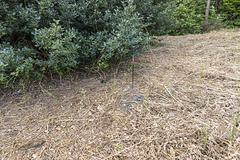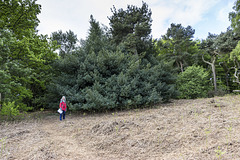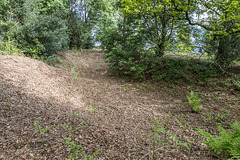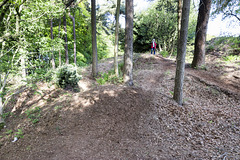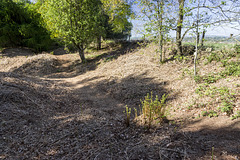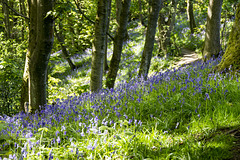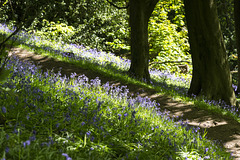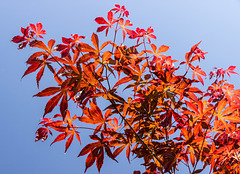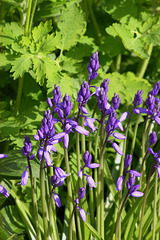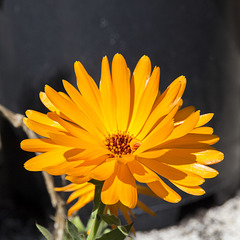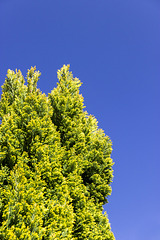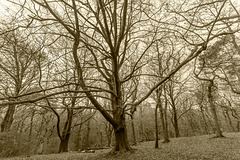Earthwatcher's photos
Bole Hill Plantation - 'holly smelter' slag tip 1
| |
|
Limb Valley Bole Hill lead smelting site
The walking stick is located on a small heap of slag adjacent to the 'holly smelter' site on the left. The holly tree is growing over the stone-walled remains of what was almost certainly a lead smelting bole, high up on the northern edge of the Bole Hill Plantation in the Limb Valley, and possibly of 18th or early 19th century age.
A small square feature, depicting a building or structure of some sort appears on the 1st edition six-inch to one mile Ordnance Survey map published in 1854. It was probably disused even then, as the map shows the plantation all around it. Subsequent editions of the maps fail to show it, although curiously the feature has been resurrected on the latest OS maps, even though the structure has long since disappeared!
There are many 'Bole Hills' in Sheffield and along the west-facing sandstone and gritstone escarpments of the Eastern Edges. Their elevated locations were ideal for wind-blown furnaces ('boles') for smelting lead ore which was brought in by pack-horses from the Peak District mines further to the west.
Bole Hill Plantation - 'holly smelter' stone work
| |
|
Limb Valley Bole Hill lead smelting site
A panoramic view showing all that remains of the stone-work at the 'holly smelter' site. The holly tree is growing over the stone-walled remains of what was almost certainly a lead smelting bole, high up on the northern edge of the Bole Hill Plantation in the Limb Valley, and possibly of 18th or early 19th century age. The walking stick is 0.9 m long.
A small square feature, depicting a building or structure of some sort appears on the 1st edition six-inch to one mile Ordnance Survey map published in 1854. It was probably disused even then, as the map shows the plantation all around it. Subsequent editions of the maps fail to show it, although curiously the feature has been resurrected on the latest OS maps, even though the structure has long since disappeared!
There are many 'Bole Hills' in Sheffield and along the west-facing sandstone and gritstone escarpments of the Eastern Edges. Their elevated locations were ideal for wind-blown furnaces ('boles') for smelting lead ore which was brought in by pack-horses from the Peak District mines further to the west.
Bole Hill Plantation - 'holly smelter' site
| |
|
|
Limb Valley Bole Hill lead smelting site
The holly tree in the centre of the photo is growing over the stone-walled remains of what was almost certainly a lead smelting bole, high up on the northern edge of the Bole Hill Plantation in the Limb Valley, and possibly of 18th or early 19th century age.
A small square feature, depicting a building or structure of some sort appears on the 1st edition six-inch to one mile Ordnance Survey map published in 1854. It was probably disused even then, as the map shows the plantation all around it. Subsequent editions of the maps fail to show it, although curiously the feature has been resurrected on the latest OS maps, even though the structure has long since disappeared!
There are many 'Bole Hills' in Sheffield and along the west-facing sandstone and gritstone escarpments of the Eastern Edges. Their elevated locations were ideal for wind-blown furnaces ('boles') for smelting lead ore which was brought in by pack-horses from the Peak District mines further to the west.
Limb Valley Bole Hill disturbed ground 4
| |
|
|
Limb Valley Bole Hill lead smelting site
Disturbed, hummocky ground high up on the northern edge of the Bole Hill Plantation in the Limb Valley. Almost certainly the remains of lead smelting boles, dating back possibly to the 17th or 18th centuries.
There are many 'Bole Hills' in Sheffield and along the west-facing sandstone and gritstone escarpments of the Eastern Edges. Their elevated locations were ideal for wind-blown furnaces ('boles') for smelting lead ore which was brought in by pack-horses from the Peak District mines further to the west.
Limb Valley Bole Hill disturbed ground 3
| |
|
|
|
Limb Valley Bole Hill lead smelting site
Disturbed, hummocky ground high up on the northern edge of the Bole Hill Plantation in the Limb Valley. Almost certainly the remains of lead smelting boles, dating back possibly to the 17th or 18th centuries.
There are many 'Bole Hills' in Sheffield and along the west-facing sandstone and gritstone escarpments of the Eastern Edges. Their elevated locations were ideal for wind-blown furnaces ('boles') for smelting lead ore which was brought in by pack-horses from the Peak District mines further to the west.
Limb Valley Bole Hill disturbed ground 2
| |
|
|
|
Limb Valley Bole Hill lead smelting site
Disturbed, hummocky ground high up on the northern edge of the Bole Hill Plantation in the Limb Valley. Almost certainly the remains of lead smelting boles, dating back possibly to the 17th or 18th centuries.
There are many 'Bole Hills' in Sheffield and along the west-facing sandstone and gritstone escarpments of the Eastern Edges. Their elevated locations were ideal for wind-blown furnaces ('boles') for smelting lead ore which was brought in by pack-horses from the Peak District mines further to the west.
Limb Valley Bole Hill disturbed ground 1
| |
|
|
Limb Valley Bole Hill lead smelting site
Disturbed, hummocky ground high up on the northern edge of the Bole Hill Plantation in the Limb Valley. Almost certainly the remains of lead smelting boles, dating back possibly to the 17th or 18th centuries.
There are many 'Bole Hills' in Sheffield and along the west-facing sandstone and gritstone escarpments of the Eastern Edges. Their elevated locations were ideal for wind-blown furnaces ('boles') for smelting lead ore which was brought in by pack-horses from the Peak District mines further to the west.
Limb Valley bluebells 2
| |
|
|
|
In late April and early May, the bluebells in the Limb Valley fill the woodland floor with a blue haze and a gorgeous scent. These are the proper native wild bluebells, Hyacinthoides non-scripta .
The cultivated garden variety, the Spanish bluebell, Hyacinthoides hispanica , is neither so beautiful, nor does it smell so sweetly. The danger is for the Spanish variety to escape and hybridise with native bluebells :-(
Limb Valley bluebells 1
| |
|
|
In late April and early May, the bluebells in the Limb Valley fill the woodland floor with a blue haze and a gorgeous scent. These are the proper native wild bluebells, Hyacinthoides non-scripta .
The cultivated garden variety, the Spanish bluebell, Hyacinthoides hispanica , is neither so beautiful, nor does it smell so sweetly. The danger is for the Spanish variety to escape and hybridise with native bluebells :-(
Clematis and bee
| |
|
|
|
A bee visiting a flower on our Clematis montana rubens , which climbs nicely on a trellis in our garden. Makes a lovely display and delicious scent for a few short weeks in Spring.
Japanese Maple
| |
|
|
Japanese Maple, Acer palmatum .
Strictly speaking, this is not in my garden but overhangs our garden fence from our neighbour. I loved the contrast of the translucent red leaves against the blue sky.
Greater Celandine
| |
|
|
We have a lot of Greater Celandine Chelidonium majus growing in our garden. The bees love it and it is a useful medicinal plant.
Bluebells focus stack
| |
|
|
|
Experimenting with focus stacking to give an increased depth of field.
Cultivated Spanish bluebells Hyacinthoides hispanica , with Greater Celandine Chelidonium majus leaves in the background.
The Spanish bluebells were here before we moved into the house, otherwise we would not have planted them ourselves; they escape into the wild too easily and hybridise with the real English bluebells Hyacinthoides non-scripta .
Marigold
| |
|
|
|
I love the vibrance of Marigold flowers, especially the original medicinal variety Calendula officinalis .
Blue sky and Leylandeii
| |
|
|
Not really a fan of Leylandeii shrubs, but we have a few in our garden.
I was struck by the bright green and yellow margins of the new growth contrasted with the intense blue northern sky on this sunny spring morning.
Summit chestnuts - sepia
| |
|
|
|
A winter's day in Ecclesall Woods, south-west Sheffield
At the summit of the higher ground in the western part of Ecclesall Woods, is a fine stand of chestnut trees. I am always intrigued by their twisted boles and branches.
I like the antique look which sepia toning gives to this image. It also concentrates the appreciation of the abstract form and semi-fractal look of the twigs and branches, without the distraction of colour.
Summit chestnuts
| |
|
|
A winter's day in Ecclesall Woods, south-west Sheffield
At the summit of the higher ground in the western part of Ecclesall Woods, is a fine stand of chestnut trees. I am always intrigued by their twisted boles and branches.
Spreading beech - sepia
| |
|
A winter's day in Ecclesall Woods, south-west Sheffield
A fine spreading beech tree on the higher ground in the western part of Ecclesall Woods, overlooking the Limb Valley.
I like the antique look which sepia toning gives to this image. It also concentrates the appreciation of the abstract form and semi-fractal look of the twigs and branches, without the distraction of colour.

